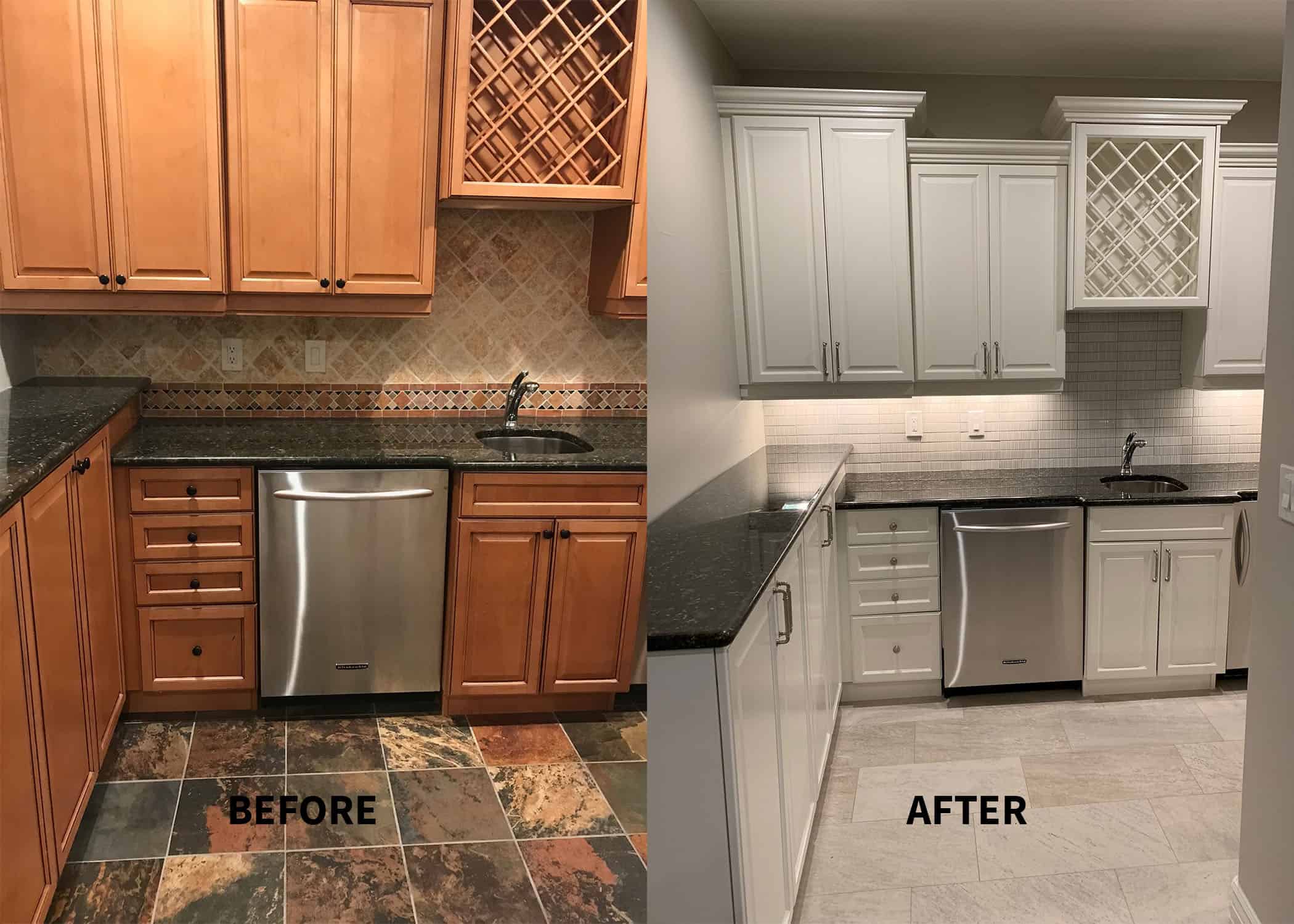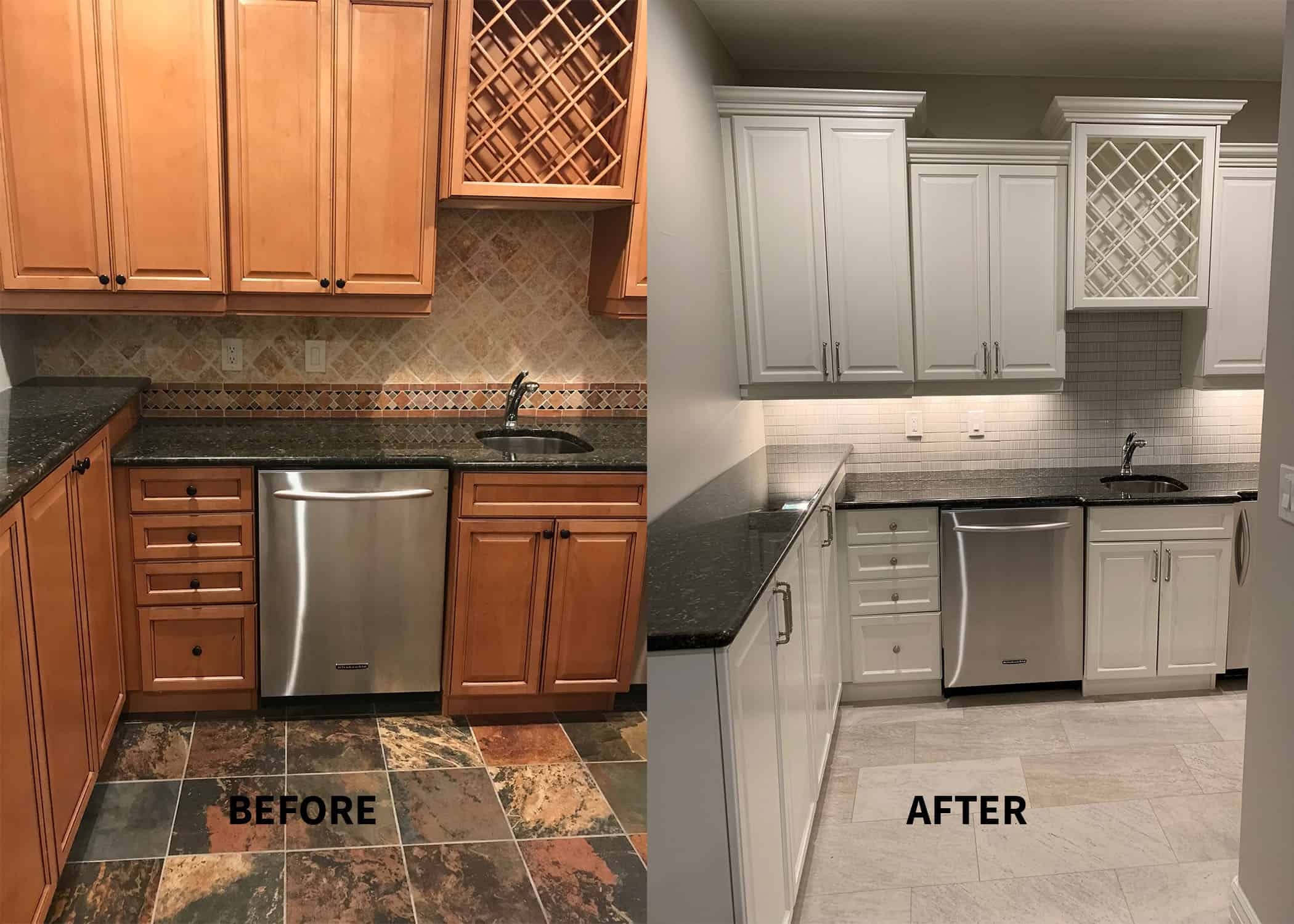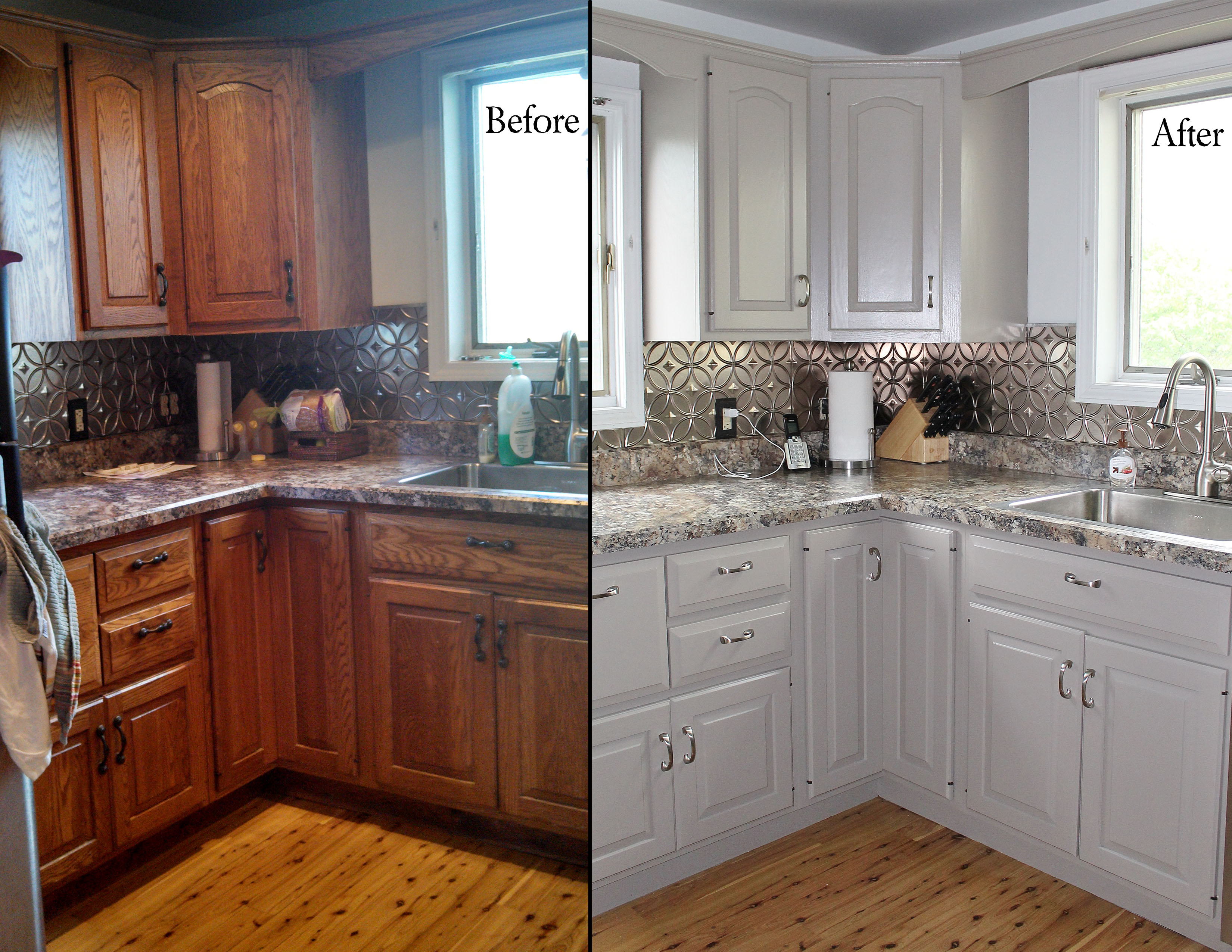Why Repaint Kitchen Cabinets Lighter?

Repainting kitchen cabinets lighter can significantly transform the ambiance and functionality of your kitchen. The shift towards lighter hues can evoke feelings of spaciousness, brightness, and cleanliness, creating a more inviting and welcoming atmosphere.
Space Perception
Lighter colors have a psychological effect on our perception of space. They tend to make a room appear larger and more expansive, a desirable effect in smaller kitchens. Darker colors, on the other hand, tend to make spaces feel more enclosed and cramped. This is due to the way light interacts with different colors. Lighter colors reflect more light, making the space appear larger, while darker colors absorb more light, making the space appear smaller.
Light Reflection
Lighter cabinets reflect more natural and artificial light, making the kitchen feel brighter and more cheerful. This is especially beneficial in kitchens with limited natural light. The increased light can also improve visibility, making it easier to prepare food and clean up. Darker cabinets, in contrast, tend to absorb light, making the kitchen feel darker and less inviting.
Maintenance, Restaining kitchen cabinets lighter
Lighter cabinets are generally easier to maintain than darker cabinets. They tend to show less dirt and grime, making them appear cleaner for longer. This is because lighter colors tend to reflect light, making any imperfections less noticeable. Darker colors, on the other hand, tend to show every speck of dust and grime, making them appear dirtier more quickly.
Kitchen Design Trends
Lighter cabinets are increasingly popular in contemporary kitchen design trends. They are often paired with light-colored countertops and backsplashes to create a cohesive and airy aesthetic. This trend is driven by a desire for open, bright, and functional kitchens. For example, the minimalist Scandinavian kitchen design often features white cabinets, light wood countertops, and natural light to create a clean and serene atmosphere.
Preparation and Materials

Before you begin repainting your kitchen cabinets, it’s crucial to gather the necessary tools and materials. This ensures a smooth and successful transformation. You will need a well-equipped arsenal of tools and materials to ensure a successful cabinet repaint.
Essential Tools and Materials
- Paint Remover: This is essential for removing old paint, varnish, or stain from the cabinet surfaces. Choose a paint remover that’s suitable for your existing finish.
- Sandpaper: Different grits of sandpaper are needed for smoothing surfaces. Start with coarse-grit sandpaper (80-120 grit) for removing old paint or varnish, then progress to fine-grit sandpaper (180-220 grit) for smoothing and preparing the surface for paint.
- Paintbrushes: High-quality paintbrushes are crucial for achieving a smooth and even finish. Choose brushes specifically designed for painting cabinets, ensuring they are appropriate for the type of paint you’ll be using.
- Paint Roller: A paint roller is helpful for covering large areas quickly and efficiently. Select a roller with a nap length that suits the type of paint and the surface you’re painting.
- Paint Tray: A paint tray is essential for holding paint and making it easy to apply with a roller.
- Drop Cloths: Protect your floors and surrounding areas from paint spills and splatters by using drop cloths. Ensure they are large enough to cover the entire work area.
- Masking Tape: Masking tape is used to protect areas you don’t want to paint, such as walls, countertops, or hardware. Choose a high-quality tape that won’t leave residue behind.
- Cleaning Supplies: You’ll need cleaning supplies, including soap, water, and a cleaning cloth, to clean the cabinets before and after sanding.
- Safety Gear: Always wear safety gear, including gloves, a mask, and eye protection, when working with paint remover, sandpaper, or paint.
- Primer: Primer is essential for creating a smooth, even surface for paint to adhere to. It helps to seal the wood and prevent the paint from absorbing into the surface.
- Paint: Select a high-quality paint specifically designed for cabinets. Consider factors such as durability, finish, and color.
- Paint Thinner: Some paints require a thinner to adjust the viscosity. Check the manufacturer’s instructions for the appropriate thinner.
- Paint Stir Stick: A paint stir stick is essential for mixing the paint thoroughly before applying it.
Preparing Kitchen Cabinets for Painting
Before you start painting, it’s crucial to prepare your cabinets properly. This involves cleaning, sanding, and priming.
Cleaning
- Remove Cabinet Doors and Hardware: To ensure a thorough cleaning and painting process, remove all cabinet doors and hardware. This allows you to work on each surface individually, achieving a professional finish.
- Wash the Cabinets: Clean the cabinets thoroughly with a mild soap and water solution. This removes dirt, grease, and grime, ensuring the paint adheres properly. Pay special attention to areas that accumulate dirt, such as handles, hinges, and corners.
- Rinse and Dry: After washing, rinse the cabinets thoroughly with clean water and dry them completely with a clean cloth. Ensure all surfaces are dry before proceeding to the next step.
Sanding
- Sand the Cabinets: Sanding is crucial for creating a smooth surface for paint to adhere to. Use coarse-grit sandpaper (80-120 grit) to remove any remaining paint, varnish, or imperfections. For existing paint, use a fine-grit sandpaper (180-220 grit) to smooth out the surface and remove any scratches or blemishes. Sanding also helps to create a slight texture that helps the paint adhere better.
- Dust the Cabinets: After sanding, use a tack cloth to remove any dust particles from the cabinet surfaces. This ensures a smooth and clean surface for priming and painting. Dust particles can interfere with the paint’s adhesion and result in an uneven finish.
Priming
- Apply Primer: Priming is essential for creating a smooth, even surface for paint to adhere to. It helps to seal the wood and prevent the paint from absorbing into the surface. Apply primer evenly to all surfaces using a brush or roller. Allow the primer to dry completely before proceeding to the next step. This ensures the paint adheres properly and prevents it from peeling or chipping.
Selecting the Right Paint and Color
- Paint Type: Choose a high-quality paint specifically designed for cabinets. Consider factors such as durability, finish, and color. For kitchen cabinets, oil-based or acrylic-based paints are popular choices. Oil-based paints offer excellent durability and a smooth, hard finish, while acrylic-based paints are water-based, making them easier to clean up and less toxic. Both types are suitable for kitchen cabinets, but it’s essential to choose a paint that meets your specific needs and preferences.
- Paint Finish: The paint finish determines the appearance of your cabinets. Consider the following options:
- Matte: A matte finish provides a flat, non-reflective surface, hiding imperfections and creating a subtle look. It’s a popular choice for traditional kitchens.
- Eggshell: An eggshell finish has a slight sheen, providing a soft, understated look. It’s a good choice for kitchens that want a touch of elegance without being too glossy.
- Satin: A satin finish has a moderate sheen, providing a slightly reflective surface that’s easy to clean. It’s a good choice for kitchens that want a touch of shine without being too glossy.
- Semi-gloss: A semi-gloss finish has a noticeable sheen, providing a reflective surface that’s easy to clean. It’s a good choice for kitchens that want a more modern look.
- Gloss: A gloss finish has a high sheen, providing a very reflective surface that’s very easy to clean. It’s a good choice for kitchens that want a high-end look.
- Paint Color: Choosing the right paint color is crucial for creating the desired look for your kitchen. Consider the following factors:
- Natural Light: The amount of natural light in your kitchen will affect how the paint color appears. A bright, sunny kitchen can handle bolder colors, while a dimly lit kitchen may benefit from lighter, more neutral colors.
- Existing Decor: Consider the existing decor in your kitchen, including countertops, backsplash, and flooring. Choose a paint color that complements these elements and creates a cohesive look.
- Personal Preference: Ultimately, the most important factor is your personal preference. Choose a paint color that you love and that will make you happy every time you walk into your kitchen.
Repainting Techniques: Restaining Kitchen Cabinets Lighter

Repainting kitchen cabinets requires the right techniques to ensure a smooth, even, and durable finish. The choice of paint application method depends on the size and complexity of the project, the type of paint used, and the desired finish.
Spray Painting
Spray painting is ideal for large areas, such as entire cabinet doors or drawer fronts. It provides a smooth, even finish, but requires careful preparation and ventilation.
- Preparation: Thoroughly clean and sand the surfaces to create a smooth, even base for the paint. Apply masking tape to protect areas that should not be painted.
- Application: Use a high-quality spray gun and apply thin, even coats of paint. Over-spraying can cause drips and runs.
- Drying Time: Allow sufficient drying time between coats, as specified by the paint manufacturer.
- Ventilation: Ensure adequate ventilation to prevent the build-up of harmful fumes.
Brush Painting
Brush painting is suitable for smaller areas, such as cabinet frames or intricate details. It provides more control and allows for a textured finish.
- Preparation: Clean and sand the surfaces as with spray painting. Use a high-quality brush with soft bristles.
- Application: Apply thin, even coats of paint, using smooth, overlapping strokes. Avoid over-brushing, which can cause streaks.
- Drying Time: Allow sufficient drying time between coats, as specified by the paint manufacturer.
- Ventilation: Ensure adequate ventilation to prevent the build-up of harmful fumes.
Roller Painting
Roller painting is a good option for large, flat surfaces, such as cabinet doors. It provides a smooth finish and is faster than brushing.
- Preparation: Clean and sand the surfaces as with spray painting. Use a high-quality roller with a nap appropriate for the paint type and surface texture.
- Application: Apply thin, even coats of paint, using smooth, overlapping strokes. Avoid rolling too fast, which can cause streaks.
- Drying Time: Allow sufficient drying time between coats, as specified by the paint manufacturer.
- Ventilation: Ensure adequate ventilation to prevent the build-up of harmful fumes.
Tips for a Smooth, Even Finish
- Thin the paint: For spray painting, thin the paint according to the manufacturer’s instructions. This will improve flow and prevent clogging.
- Use a primer: A primer helps to create a smooth, even base for the paint and improves adhesion.
- Apply multiple thin coats: Applying multiple thin coats is better than one thick coat. This allows the paint to dry evenly and prevents drips and runs.
- Sand between coats: Lightly sand between coats to smooth out any imperfections.
- Use a paint scraper: Remove any drips or runs before they dry.
Drying Time and Ventilation
- Drying Time: Allow sufficient drying time between coats, as specified by the paint manufacturer. This ensures the paint cures properly and creates a durable finish.
- Ventilation: Ensure adequate ventilation during and after painting to prevent the build-up of harmful fumes. Open windows and doors, and use fans to circulate air.
Restaining kitchen cabinets lighter – Re-staining your kitchen cabinets lighter can make a world of difference, brightening up the space and giving it a fresh, airy feel. But remember, you’ll want to illuminate those newly light cabinets with the right kind of lighting! Consider battery operated under cabinet lighting for a sleek and easy way to highlight your beautiful new cabinets without the hassle of wiring.
You’ll be amazed at how much brighter and more inviting your kitchen feels!
Want to give your kitchen a fresh, modern look without a full remodel? Re-staining your kitchen cabinets lighter can do wonders! Think about the classic combination of maple cabinets and white countertops , but with a lighter stain on the cabinets, the whole space feels airy and bright.
It’s a simple trick that can transform your kitchen from cozy to chic in a weekend!